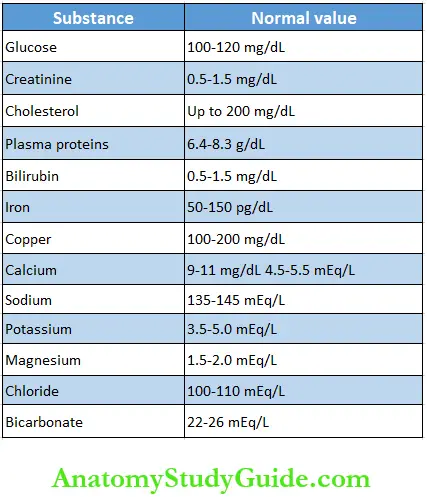Blood Introduction
- Blood is a connective tissue in fluid form. It is considered as the fluid of life because it carries oxygen from lungs to all parts of the body and carbon dioxide from all parts of the body to the lungs.
- It is known as the fluid of growth because it carries nutritive substances from the digestive system and hormones from the endocrine gland to all the tissues.
- The blood is also called the fluid of health because it protects the body against diseases and gets rid of waste products and unwanted substances by transporting them to the excretory organs like kidneys.
Read And Learn More: Medical Physiology Notes
Table of Contents
Properties Of Blood
- Color: Blood is red in color. Arterial blood is scarlet red because it contains more oxygen and venous blood is purple red because of more carbon dioxide.
- Volume: The average volume of blood in a normal adult is 5 L. In newborn baby the volume is 450 ml. It increases during growth and reaches 5 L at the time of puberty. In females, it is slightly less and is about 4.5 L. It is about 8% of the body weight in a normal young healthy adult weighing about 70 kg.
- Reaction and pH: Blood is slightly alkaline and its pH in normal conditions is 7.4.
- Specific gravity:
- The specific gravity of total blood: 1.052 to 1.061
- The specific gravity blood cells: 1.092 to 1.101
- The specific gravity of plasma: 1.022 to 1.026
- Viscosity: Blood is five times more viscous than water. It is mainly due to red blood cells and plasma proteins.
Composition Of Blood
Blood contains the blood cells which are called formed elements and the liquid portion known as plasma.
Composition Of Blood Cells: Three types of cells are present in the blood:
- Red blood cells or erythrocytes
- White blood cells or leukocytes
- Platelets or thrombocytes
Hematocrit Value
- If blood is collected in a hematocrit tube along with a suitable anticoagulant and centrifuged for 30 minutes at a speed of 3000 rpm (revolutions per minute), the red blood cells settle down at the bottom having a clear plasma at the top.
- The plasma forms 55% and the red blood cells form 45% of the total blood. The volume of red blood cells expressed in percentage is called the hematocrit value or packed cell volume (PCV).
- In between the plasma and the red blood cells there is a thin layer of white buffy coat. This white buffy coat is formed by the aggregation of white blood cells and platelets.
Composition Of Plasma
- Plasma is a straw-colored clear liquid part of blood. It contains 91-92% of water and 8-9% of solids.
- The solids are the organic and the inorganic substances. Table gives the normal values of some important substances in blood.

Composition Of Serum
- Serum is the clear straw-colored fluid that is left after blood has clotted. When the blood is shed or collected in a container, it clots.
- In this process, the fibrinogen is converted into fibrin and the blood cells are trapped in this fibrin forming the blood clot. After about 45 minutes, a straw-colored serum oozes out of the blood clot.)
- The serum is separated from blood cells and clotting elements by centrifuging. Serum has approximately the same volume of plasma (55%).
- It is different from plasma only by the absence of fibrinogen, i.e. serum contains all the other constituents of plasma except fibrinogen. The fibrinogen is absent in serum because it is converted into fibrin during blood clotting.
Thus, the Serum = Plasma – Fibrinogen.

Functions
Functions Of Blood
- Nutrient Function: Nutritive substances like glucose, amino acids, lipids, and vitamins derived from digested food are absorbed from the gastrointestinal tract and carried by the blood to different parts of the body for growth and production of energy.
- Respiratory Function: Transport of respiratory gases is done by the blood. It carries oxygen from the alveoli of the lungs to different tissues and carbon dioxide from tissues to alveoli.
- Excretory Function: Waste products formed in the tissues during various metabolic activities are removed by blood and carried to the excretory organs like kidney, skin, liver, etc. for excretion.
- Transport Of Hormones And Enzymes: Hormones which are secreted by ductless (endocrine) glands are released directly into the blood. The blood transports these hormones to their target organs/ tissues. Blood also transports enzymes.
- Regulation Of Water Balance: The water content of the blood is freely interchangeable with interstitial fluid. This helps in the regulation of water content of the body.
- Regulation Of Acid-Base Balance: The plasma proteins and hemoglobin act as buffers and help in the regulation of acid-base balance.
- Regulation Of Body Temperature: Because of the high specific heat of blood, it is responsible for maintaining the thermoregulatory mechanism in the body, i.e. the balance between heat loss and heat gain in the body.
- Storage Function:
- Water and some important substances like proteins, glucose, sodium, and potassium are constantly required by the tissues. Blood serves as a readymade source for these substances.
- And, these substances are taken from blood during the conditions like starvation, fluid loss, electrolyte loss, etc.
- Defensive Function:
- Blood plays an important role in the defense of the body. The white blood cells are responsible for this function. Neutrophils and monocytes engulf the bacteria by phagocytosis.
- Lymphocytes are involved in the development of immunity. Eosinophils are responsible for detoxification, disintegration, and removal of foreign proteins.
Leave a Reply